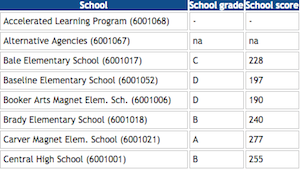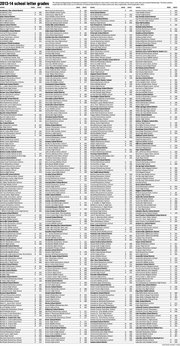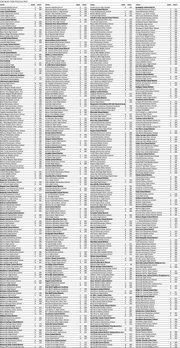Arkansas' more than 1,000 public schools received letter grades Wednesday ranging from A's for excellence to F's for schoolwide low achievement, just like the grades the schools give to their students.
In all, 162 Arkansas public schools earned A grades, and 43 schools received F's for achievement on state math and literacy tests and high school graduation.
The letter grades and the number of points on which the grades were based are posted on the Arkansas Department of Education's newly released online 2013-14 "Report Card" for each school.
In addition to the schools receiving A's and F's, 322 schools received B's, 365 schools earned C's, and 158 received D's.
The letter grades are required by Act 696 of 2013. They replace the older, little-noticed state practice of rating schools on a scale of 1-5 on the annual report cards. The letter grades are meant to be easier for parents and other community members to understand.
The letter grades and the report cards -- which contain multiple kinds of data for the three most recently completed school years and are more than a dozen pages long for each school -- are available on the department's website: arkansased.gov.
"As a parent, I celebrate when my child does well in school and also look for ways to help her advance in areas that need improvement," Johnny Key, Arkansas' new education commissioner, said Wednesday in an emailed statement. "We encourage parents and patrons of all school districts to use the school grades in the same manner -- as a tool to improve student academic performance."
The new letter grades, which will not carry any penalties or rewards for the schools, took into account school results on state-required Benchmark and End-of-Course math and literacy tests; any year-to-year gains that were made by the school on the state tests; the size of achievement gaps among student groups at a school; and, if applicable, a school's graduation rate. The formula also took into account any differences in graduation rates among student subgroups at a school.
Each school could earn up to 300 points. A school earning 270 or more points was assigned an A. One with 240-269 points was given a B. A school with 210-239 points qualified for a C, and one with 180-209 points was given a D. Schools with fewer than 180 points received F's.
The formula for calculating the letter grades was developed by the University of Arkansas at Fayetteville's Office of Innovation for Education in consultation with the Education Department staff, leaders of administrator and teacher organizations, and representatives of philanthropic groups.
The formula was designed to mitigate the effect of school characteristics such as the percentage of students from impoverished families or the size of the schools.
Schools in the Little Rock district, the state's largest, with 24,000 students, received school grades that ran the gamut. Four schools -- Forest Park, Terry, Don Roberts and Carver Magnet elementary schools all received A's, with Forest Park receiving a perfect score of 300 points.
Six schools received B's: Jefferson, Williams Magnet, Gibbs Magnet and Brady elementaries, along with Parkview Magnet and Central high schools. Nine schools received C's, and 14 received D's.
Eight schools received F's: Romine and Geyer Springs elementary schools, Mabelvale, Henderson, Cloverdale and Forest Heights middle schools, and Hall and J.A. Fair high schools. But Geyer Springs Elementary has since been converted to a gifted-education academy, and Forest Heights Middle has been converted to a kindergarten-through-eighth grade science and math academy.
Four of the district's state-labeled academically distressed schools are among the schools to receive F's: Hall, Fair, Cloverdale and Henderson. McClellan High and Baseline Elementary, which are also academically distressed because fewer than 50 percent of students scored at proficient levels over a three-year period, earned D's.
Little Rock interim Superintendent Dexter Suggs said Wednesday that he sees two sides to the letter grading system.
"In a roundabout way, it's a good method because it highlights some things for us," Suggs said. "But that's with the understanding, also, that the grading scale doesn't necessarily define that school, and it definitely does not define the people in the school.
"The reality of it is that if I'm coming into the city, that's going to be one of the tools I'm going to use to make a determination about the school I want to go to," he continued. "We have to find ways to improve. It's going to force us to look at each individual student at each school and figure how how we can help that child be successful."
In North Little Rock, Seventh Street Elementary received an A; Glenview and Lakewood elementaries received B's; and Ridgeroad Middle, which is being converted into an elementary school for next year, received an F. Other schools received C's and D's.
North Little Rock Superintendent Kelly Rodgers said district leaders have known for some time what the 2014 state test results were for the North Little Rock schools.
"Since then, we have already made major improvements on creating smaller, more individual learning centers for our students, as well as increasing student access to needed technology," Rodgers said in a news release that also described in some detail new employee evaluation systems, specialization of instruction by elementary teachers, after-school tutoring initiatives, use of project-based learning in classrooms, expansion of graduation credit-recovery programs to increase high school graduation and other efforts to improve student achievement.
"Even though these grades were just released, they are still a year old," Rodgers said. "These grades reflect where we were and not necessarily where we are and where we're headed."
In the Pulaski County Special School District, College Station and Baker elementary schools received A's. Four schools received B's: Robinson, Arnold Drive and Chenal elementaries and Maumelle High. Jacksonville Middle, Fuller Middle and Northwood Middle schools received F's.
Northwood, which was just one point away from a D, will close next year, and Jacksonville Middle students and the staff will move into the Northwood campus temporarily.
Lance LeVar, interim principal of the 413-pupil Northwood, said he and his staff looked at the test results last summer and put changes in place.
"We knew we would get a low grade in the first place, but we decided that we can't let this be the status quo," he said, then described how advisers are working with students and how every student with D's and F's must go to tutoring, while those with higher grades get a reward.
"We have brought up hundreds of grades over the last semester that we've done this."
Additionally, the school paid its core academic teachers to spend two days refining the curriculum, he said, adding that teacher attendance is better this school year and that the culture of the school has changed for the better.
LeVar said he appealed to the state to change the F grade at the school, but the appeal wasn't accepted.
"It is what it is. It's frustrating to me, even though I wasn't here last year," he said.
"A report that is based entirely on math and literacy scores is not a report that tells how well a school is doing. I'm not minimizing the importance of that data. If I were to give a student in my class a letter grade for the whole year based on one test, how many parents would be up in arms against me? That's what the state has done."
School district leaders elsewhere in the state had mixed reactions to the letter grades.
"This was advertised as a way to make it more simplified, but I can tell you that parents are being overwhelmed with so many different types of rating systems," Cabot Superintendent Tony Thurman said Wednesday. "Every week, there seems to be a different rating that is being shared. It is confusing."
Four schools in the 10,172-student Cabot district got A's, three earned B's and seven received C's.
"One of my schools that got a C was also named last month as an Arkansas Diamonds school; that means it's in the top 10 percent of middle schools. One of the schools received $77,000 in improvement award money and another received $69,000. The two junior highs are well above average, and one received $111,000 in improvement money, but then we are given a C. The conflicting information makes people question what is really happening in our schools," Thurman said.
"I understand their rationale with this system, but this is going to make it even more confusing," Thurman continued.
"Public education gets battered often. There are a lot of good things happening, but they are overshadowed by results like this," Thurman said.
Lynne Dardenne, superintendent of the 1,264-student DeWitt School District, said the letter grades are hard to find on the multipage report card for each school.
"We will look into those areas in which we need to improve and call on our community and parents to help us," Dardenne said. "And we will stay committed to do well on those areas where we excelled. I think it all goes back to the fact that we have an excellent community and excellent teachers. I would put up the support this community shows its schools against any other city in the state of Arkansas. I am very pleased to be here."
"I have some very mixed feelings about the letter grade system," Dardenne said. "There are some things that need to be addressed, including that not everyone is held accountable to the same standard. That is the main concern I have with the system. A neighboring district may have received a higher grade, but their annual measurable objective may be lower. Everybody has an idea of what an A-F grade system means. We need to all be held to that same standard."
Sarah McKenzie, executive director of the Office for Education Policy at the University of Arkansas, said the school grades are just one indicator of quality. The grades shouldn't define the schools, she said.
"I think that's why the state department chose to put the grade deeper in the report card, because they didn't want to overplay the importance of those letter grades," McKenzie said.
She believes that the letter-grade system is better than the Elementary Secondary Education Act system, which has resulted in 94 percent of schools being assigned, at some level, the "needs improvement" status. The new system includes a weighted model of test score evaluations, so it rewards schools for reaching higher levels of proficiency on state tests, she said.
"I think my favorite new piece is the measure of the achievement gap and graduation gap between those students deemed at-risk and those who are not," McKenzie said of the report card. "That's a valuable piece of information, how schools are serving all students."
She said the public shouldn't assume C-grade schools are doing poorly.
"With B and C schools, little differences can make big impacts on their scores," McKenzie said. "D and F schools should not come as a surprise, necessarily. I think those are schools that have historically had troubles with student achievement."
The letter-grading formula is made up of several components, and each component requires its own set of calculations. There's a calculation for determining points for student performance. There is a different multistep calculation for determining points for improvement or meeting some or all of a schools's annual achievement goals.
Schools have varying goals based on the different numbers of tests that are given in an elementary school as opposed to a middle and high schools.
Points also are given for a school's graduation rate, if applicable, and for the achievement gap or graduation gap between all students and at-risk students at a school. At-risk students are those who are from low-income families, do not speak English as a first languageor are special education students.
The formula for calculating points for a high school is: (Weighted performance + Gap adjustment) + (Improvement) + (Graduation rate + Gap adjustment.)
For schools without graduation rates, the formula is: (1.5) x (Weighted performance + Gap adjustment) + (1.5) x (Improvement). The 1.5 multiplier is used to put the scores on a scale of 300 possible points.
Robert Edwards, the new superintendent of the 689-student Lafayette County School District based in Lewisville, was pleased with the B and C grades given the district's two campuses.
"This is my first year here, so the grades really have nothing to do with me, but I think it's an awesome feat. We have 83 percent free-and-reduced-lunch [income-eligible] students. That just goes to prove that all children can learn. Our teachers and administrators have done a marvelous job. I am extremely proud."
Information for this article was contributed by Dave Perozek of the NWA Democrat-Gazette.
Metro on 04/16/2015




